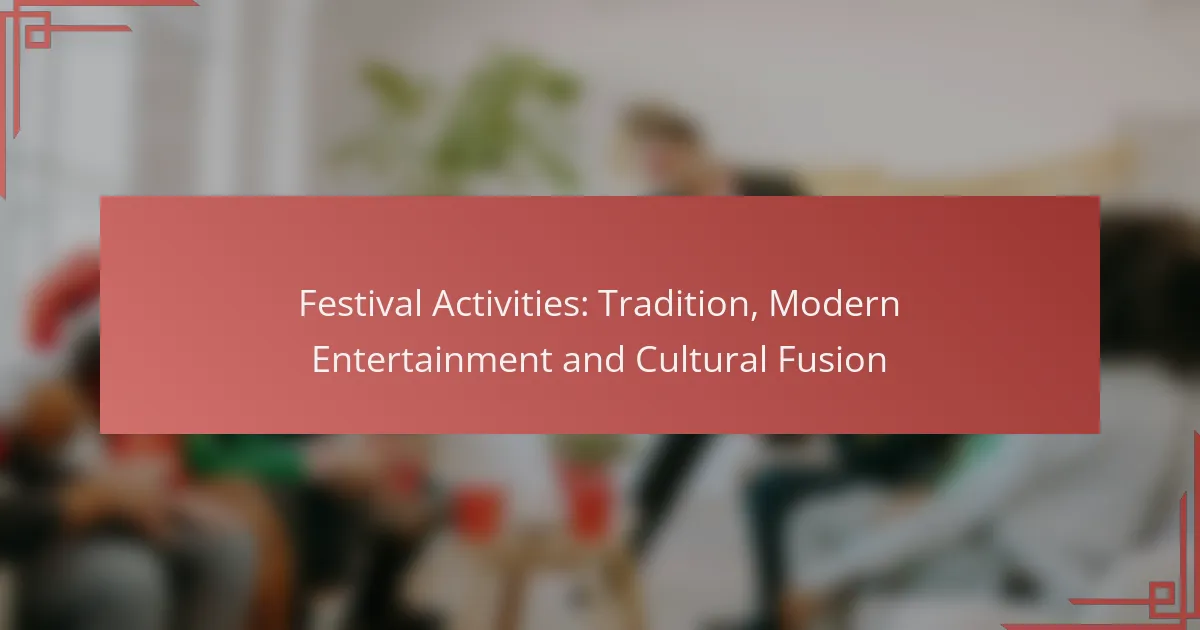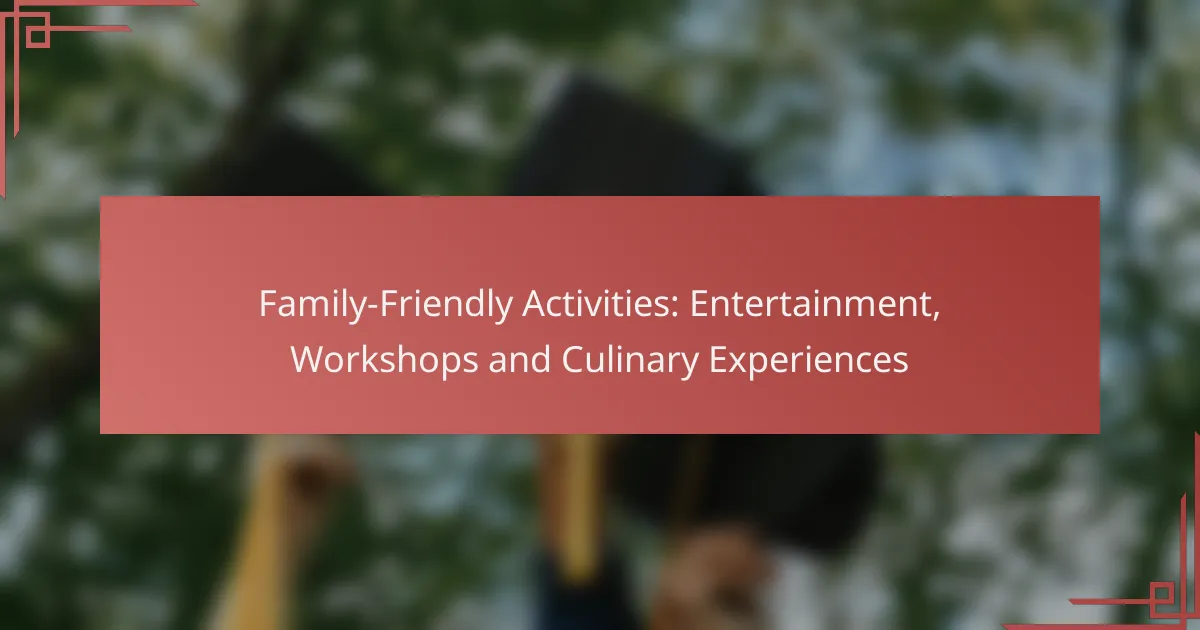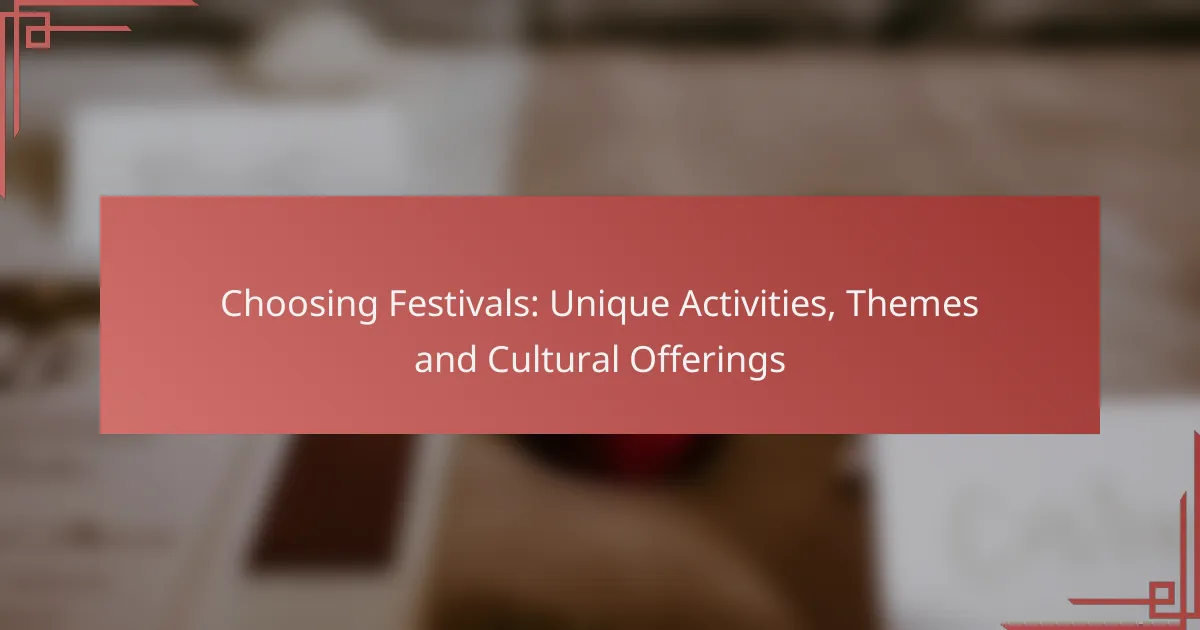Festivals serve as vibrant celebrations of cultural heritage, community spirit, and seasonal changes, featuring traditional activities like parades and craft fairs that reflect local customs. Modern entertainment enhances these events, attracting diverse audiences and creating immersive experiences that blend the old with the new. Additionally, cultural fusion in festivals showcases a rich tapestry of traditions, merging elements from various cultures to create unique and memorable celebrations.
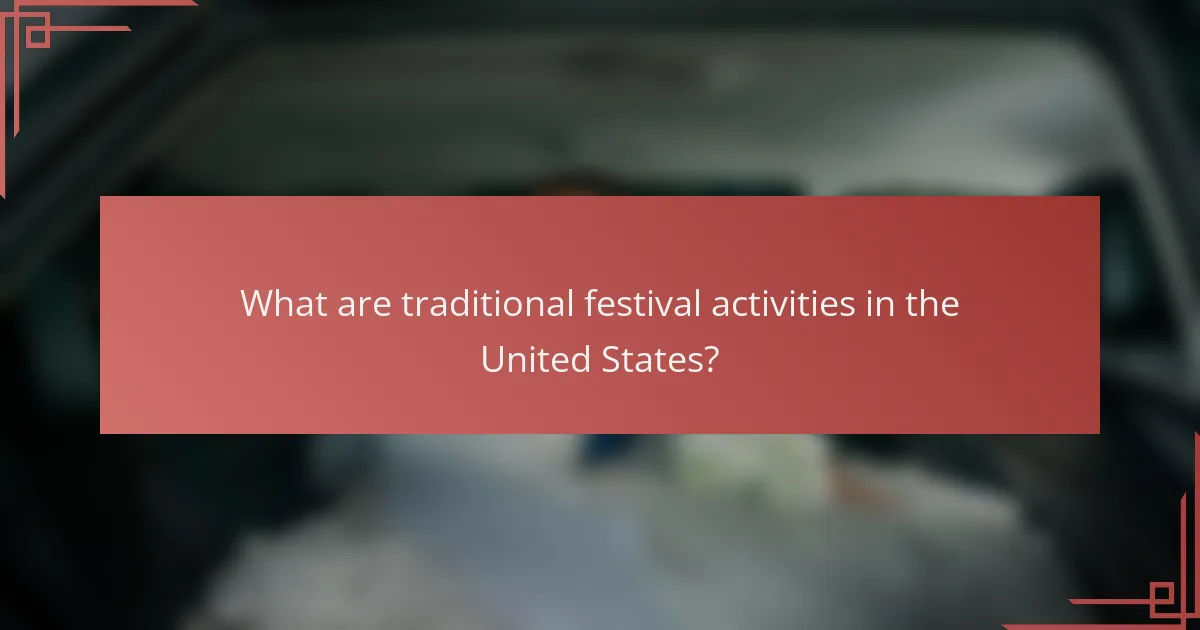
What are traditional festival activities in the United States?
Traditional festival activities in the United States encompass a variety of events that celebrate cultural heritage, community spirit, and seasonal changes. These activities often include parades, cultural performances, and craft fairs, each offering unique experiences that reflect local customs and traditions.
Parades and processions
Parades and processions are a hallmark of many American festivals, showcasing vibrant floats, marching bands, and community groups. Events like the Macy’s Thanksgiving Day Parade and local Fourth of July parades draw large crowds and foster a sense of unity among participants and spectators.
When attending a parade, consider arriving early to secure a good viewing spot. Check local schedules for specific themes or featured performances, as these can vary significantly from year to year.
Cultural performances
Cultural performances at festivals highlight the diverse heritage of American communities through music, dance, and theater. Events such as the Albuquerque International Balloon Fiesta often include traditional Native American dances, while other festivals may feature jazz, blues, or folk music.
To fully enjoy these performances, familiarize yourself with the artists and their cultural backgrounds. Engaging with performers after the shows can enhance your understanding and appreciation of the traditions being showcased.
Craft fairs
Craft fairs are popular at many festivals, providing a platform for local artisans to display and sell handmade goods. These fairs often feature a range of products, from pottery and textiles to jewelry and food items, allowing visitors to support local economies.
When visiting a craft fair, look for unique items that reflect the local culture. Be prepared to negotiate prices, as many artisans welcome haggling, especially for bulk purchases. Bring cash, as some vendors may not accept credit cards.
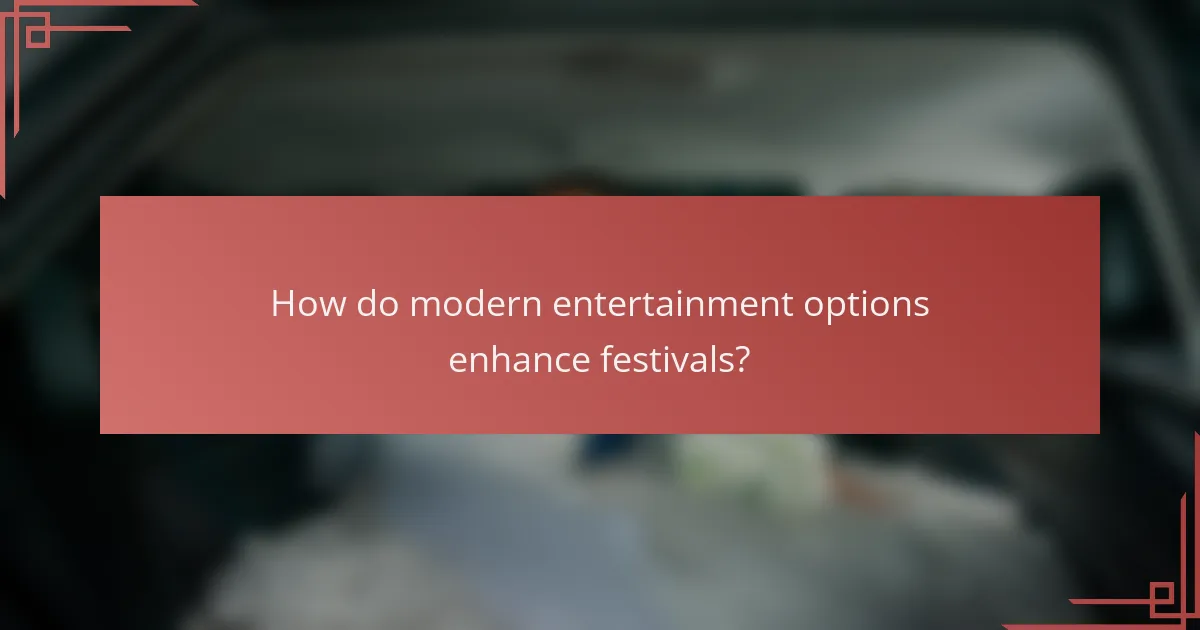
How do modern entertainment options enhance festivals?
Modern entertainment options significantly enhance festivals by attracting diverse audiences and creating immersive experiences. These activities blend tradition with contemporary elements, making events more engaging and memorable.
Live music concerts
Live music concerts are a staple of many festivals, offering a platform for both established and emerging artists. They create a vibrant atmosphere that encourages social interaction and enjoyment among attendees.
When planning a festival, consider featuring a mix of genres to appeal to different tastes. For example, incorporating local bands alongside popular acts can draw in larger crowds while supporting the community.
Food truck gatherings
Food truck gatherings provide a diverse culinary experience, showcasing local flavors and innovative dishes. These mobile kitchens allow festival-goers to sample a variety of foods, enhancing the overall festival experience.
To maximize the appeal of food trucks, curate a selection that includes vegetarian, vegan, and gluten-free options. This ensures that all attendees can find something enjoyable to eat, which can significantly boost satisfaction and return rates.
Interactive art installations
Interactive art installations invite festival attendees to engage with the artwork, fostering creativity and participation. These installations can range from large-scale sculptures to immersive digital experiences, making art accessible and enjoyable for everyone.
When incorporating interactive art, consider the space and resources available. Collaborating with local artists can also enhance community ties and provide unique experiences that reflect the festival’s cultural identity.
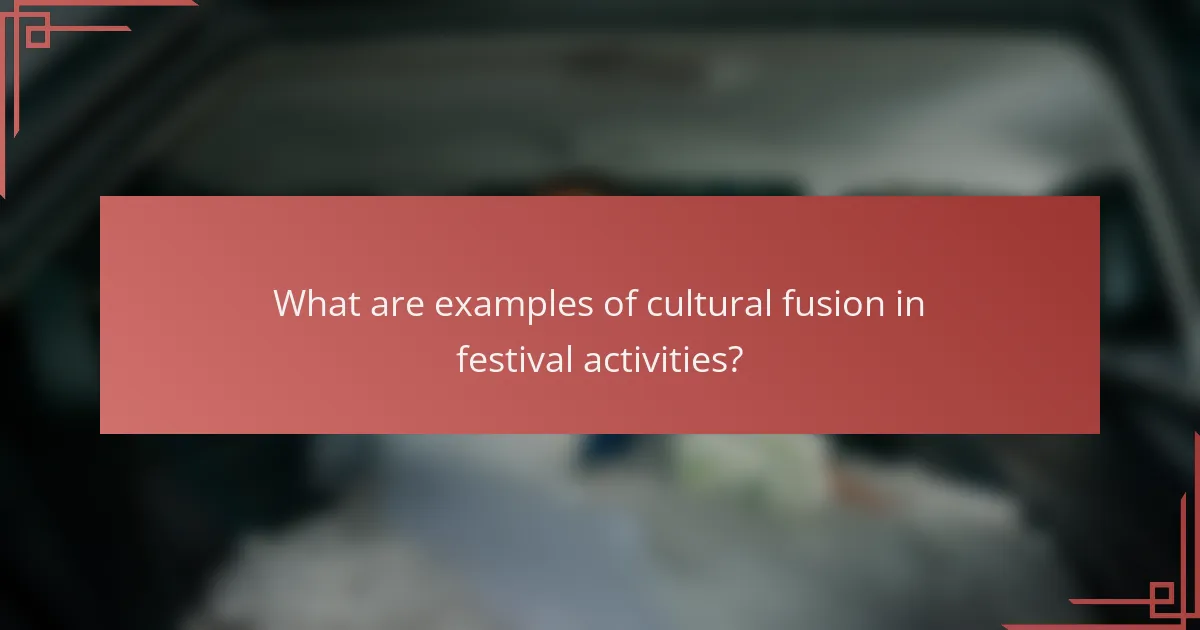
What are examples of cultural fusion in festival activities?
Cultural fusion in festival activities often blends traditions, customs, and entertainment from different cultures, creating unique celebrations. Examples include Dia de los Muertos, Chinese New Year, and Carnevale di Venezia, each showcasing a mix of historical and contemporary elements.
Dia de los Muertos celebrations
Dia de los Muertos, or Day of the Dead, is a Mexican festival that honors deceased loved ones through vibrant altars, offerings, and parades. It combines indigenous traditions with Spanish influences, featuring colorful decorations, sugar skulls, and marigolds, which symbolize the cycle of life and death.
During this celebration, families gather to create altars (ofrendas) adorned with photographs, favorite foods, and personal items of the departed. The fusion of ancient rituals and modern festivities makes Dia de los Muertos a rich cultural experience, attracting visitors from around the world.
Chinese New Year festivals
Chinese New Year festivals are celebrated globally, showcasing a blend of traditional customs and contemporary entertainment. The festivities include lion dances, fireworks, and family reunions, symbolizing prosperity and good fortune for the coming year.
In many cities, these celebrations feature cultural performances that incorporate elements from various regions, such as martial arts demonstrations and modern music. The fusion of age-old traditions with modern interpretations creates a dynamic atmosphere that engages participants of all ages.
Carnevale di Venezia
Carnevale di Venezia, or Venice Carnival, is renowned for its elaborate masks and costumes, blending historical Venetian traditions with modern artistic expressions. This festival features parades, theatrical performances, and masquerade balls, attracting tourists eager to experience its unique charm.
The event showcases a mix of local culture and international influences, with participants often incorporating contemporary themes into their costumes. This cultural fusion enhances the festival’s appeal, making it a vibrant celebration of creativity and heritage.

What criteria should be considered when planning festival activities?
When planning festival activities, it’s essential to consider factors such as the target audience, budget, and logistical requirements. These elements will shape the overall experience and ensure that the festival meets its goals and resonates with attendees.
Target audience demographics
Understanding the target audience demographics is crucial for selecting appropriate activities. Consider age, cultural background, interests, and preferences to tailor the festival experience. For instance, a family-oriented festival may prioritize kid-friendly events, while a music festival might focus on popular genres appealing to younger adults.
Conduct surveys or analyze past attendance data to gain insights into your audience. This information can guide decisions on programming, marketing strategies, and even the festival’s location.
Budget and sponsorship
Establishing a clear budget is vital for successful festival planning. Determine the total available funds and allocate resources for various activities, marketing, staffing, and venue costs. A well-defined budget helps prevent overspending and ensures all aspects of the festival are adequately funded.
Sponsorship can significantly enhance your budget. Approach local businesses or larger corporations that align with your festival’s theme for potential partnerships. Offer them visibility in exchange for financial support, which can help cover costs and improve the festival’s overall quality.
Logistical requirements
Logistical planning encompasses various aspects, including venue selection, permits, and equipment rentals. Ensure that the chosen location can accommodate the expected crowd and has the necessary facilities, such as restrooms and parking. Additionally, check local regulations for permits required for hosting events.
Consider the timeline for setup and breakdown, as well as the availability of vendors and performers. Creating a detailed schedule can help coordinate activities and ensure a smooth flow throughout the festival. Always have contingency plans in place for unexpected challenges, such as weather changes or technical issues.
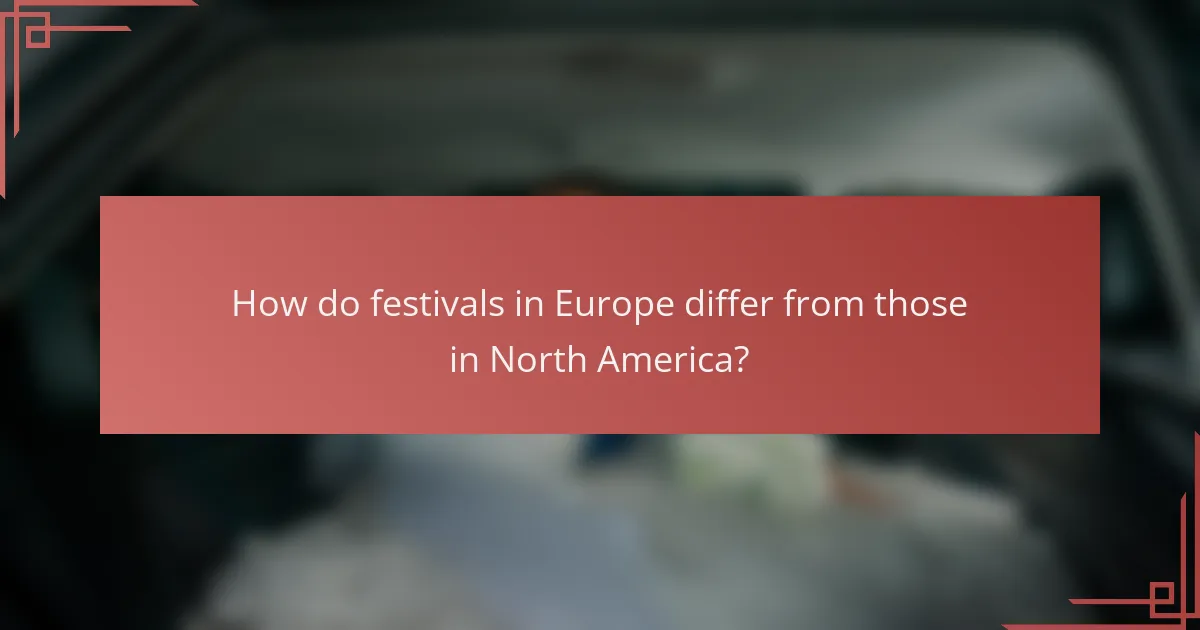
How do festivals in Europe differ from those in North America?
Festivals in Europe often emphasize historical traditions and cultural heritage, while North American festivals tend to focus on modern entertainment and diverse cultural influences. This distinction shapes the overall experience, activities, and community involvement at these events.
Historical significance
European festivals frequently celebrate centuries-old traditions and local customs, reflecting the rich history of the region. Events like Oktoberfest in Germany or La Tomatina in Spain are rooted in historical practices, often linked to agricultural cycles or religious observances.
In contrast, many North American festivals are relatively new, often created to celebrate cultural diversity or specific themes, such as music or food. Events like the Coachella Valley Music and Arts Festival or the Albuquerque International Balloon Fiesta showcase contemporary culture rather than historical roots.
Types of activities offered
European festivals typically feature traditional activities such as folk dancing, artisanal crafts, and local cuisine, providing an immersive cultural experience. Visitors can expect to see parades, historical reenactments, and regional specialties that highlight the area’s heritage.
North American festivals, on the other hand, often prioritize modern entertainment, including live music performances, food trucks, and interactive exhibits. These events may incorporate a variety of cultural influences, offering a mix of activities that appeal to a broader audience, such as film screenings, art installations, and sports competitions.
